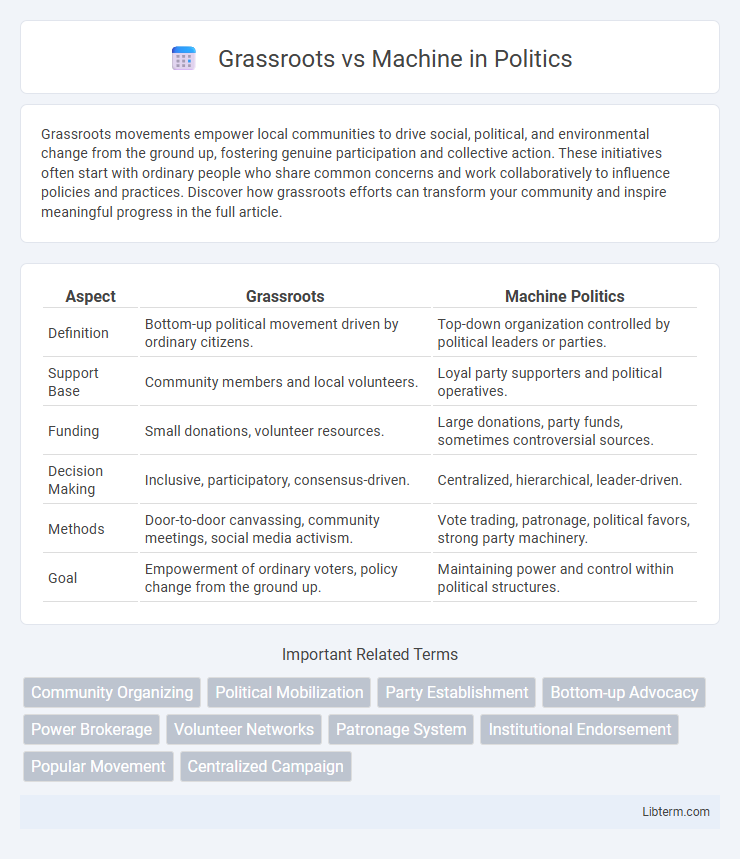Grassroots movements empower local communities to drive social, political, and environmental change from the ground up, fostering genuine participation and collective action. These initiatives often start with ordinary people who share common concerns and work collaboratively to influence policies and practices. Discover how grassroots efforts can transform your community and inspire meaningful progress in the full article.
Table of Comparison
| Aspect | Grassroots | Machine Politics |
|---|---|---|
| Definition | Bottom-up political movement driven by ordinary citizens. | Top-down organization controlled by political leaders or parties. |
| Support Base | Community members and local volunteers. | Loyal party supporters and political operatives. |
| Funding | Small donations, volunteer resources. | Large donations, party funds, sometimes controversial sources. |
| Decision Making | Inclusive, participatory, consensus-driven. | Centralized, hierarchical, leader-driven. |
| Methods | Door-to-door canvassing, community meetings, social media activism. | Vote trading, patronage, political favors, strong party machinery. |
| Goal | Empowerment of ordinary voters, policy change from the ground up. | Maintaining power and control within political structures. |
Understanding Grassroots Movements
Grassroots movements emerge from the community level, driven by ordinary people advocating for social or political change, emphasizing local concerns and direct participation. These movements rely on collective action, strong community networks, and shared values to influence policy and societal norms without centralized control. Understanding grassroots efforts involves recognizing their organic nature, emphasis on inclusivity, and the power of mobilizing individuals around common goals to challenge established institutions or machine-driven agendas.
Defining Political Machines
Political machines are organized groups led by a central authority that command voter loyalty through patronage and controlled resources, often exerting significant influence over local government and elections. They operate through hierarchical structures that prioritize efficiency and control, leveraging tactics like vote-buying and favors to maintain power. In contrast, grassroots movements arise organically from community members aiming to promote collective interests without centralized control or reliance on patronage.
Historical Context: Grassroots and Machines
Grassroots political movements originated in the early 19th century as community-based efforts emphasizing local participation and democratic ideals, while political machines rose prominently in urban America during the late 19th and early 20th centuries, characterized by hierarchical organization and patronage systems. The historical tension between grassroots activism and political machines shaped the development of party politics, with machines often controlling elections through voter mobilization and patronage, contrasting with grassroots campaigns advocating reform and citizen empowerment. Key examples include Tammany Hall in New York City as a dominant political machine and the Progressive Era reforms that sought to curb machine influence by promoting grassroots engagement.
Organization and Structure Differences
Grassroots movements rely on decentralized organization with flexible, community-driven structures that empower local participants to lead initiatives and make decisions collectively. Machine politics depends on highly centralized, hierarchical organizations where leaders control resources, nominations, and campaign strategies to maintain party loyalty and influence. The contrasting structures result in grassroots emphasizing bottom-up engagement, while machines prioritize top-down control for efficient mobilization and electoral success.
Mobilization Strategies Compared
Grassroots mobilization relies heavily on local community engagement, personal connections, and volunteer networks to inspire collective action and build trust through face-to-face interactions. Machine-driven mobilization strategies prioritize data analytics, targeted messaging, and automated outreach tools to efficiently identify and influence voters on a large scale. Both approaches offer distinct advantages: grassroots efforts enhance authenticity and sustained involvement, while machine tactics provide precision and scalability in voter mobilization.
Funding Sources and Financial Influence
Grassroots movements primarily rely on small donations from individual supporters, emphasizing community-driven funding and limited financial influence. In contrast, machine politics often depend on large contributions from corporate donors, political action committees (PACs), and special interest groups, resulting in substantial financial leverage. This divergence in funding sources significantly impacts the scale, outreach, and policy priorities of each approach.
Impact on Voter Engagement
Grassroots campaigns significantly enhance voter engagement by fostering personal connections through community organizing and local volunteer efforts, resulting in higher turnout and sustained political participation. Machine-driven campaigns rely heavily on data analytics and targeted advertising to mobilize voters efficiently but often lack the personalized outreach that builds long-term trust and enthusiasm. The combination of grassroots authenticity with machine precision can optimize voter mobilization, maximizing both reach and impact.
Success Stories: Grassroots vs Machine
Grassroots movements have driven significant change by mobilizing local communities and leveraging authentic personal stories, exemplified by the Arab Spring, where decentralized protests led to political reforms. Machine-led campaigns use data-driven strategies and automation to achieve rapid scalability, with successes like Netflix's recommendation algorithm optimizing user engagement and retention. Combining grassroots passion with machine efficiency enhances overall impact, as seen in hybrid models like Barack Obama's 2008 presidential campaign, which integrated volunteer networks with sophisticated data analytics.
Criticisms and Controversies
Grassroots movements often face criticisms related to lack of formal organization and difficulties in sustaining long-term impact, while machines and automated systems are frequently scrutinized for ethical concerns, bias in algorithms, and potential job displacement. Controversies around grassroots efforts include accusations of inefficiency and susceptibility to manipulation by external forces, whereas machine-driven processes provoke debate on privacy invasion and diminished human agency. Both approaches highlight tensions between human-driven initiative and technological control in social and political activism.
Future Trends in Political Organizing
Grassroots movements increasingly harness digital platforms and AI-driven analytics to mobilize supporters, targeting specific demographics with personalized messaging that boosts engagement and fundraising. Machine-driven campaigns utilize big data and predictive algorithms to optimize voter outreach, enabling precise micro-targeting and resource allocation. Future trends suggest a hybrid model where human-led passion combines with machine-powered efficiency to enhance political organizing accuracy and impact.
Grassroots Infographic

 libterm.com
libterm.com